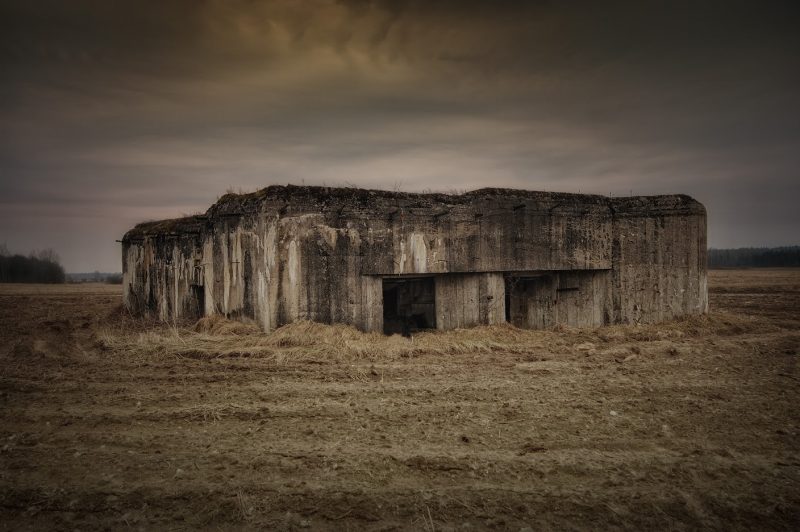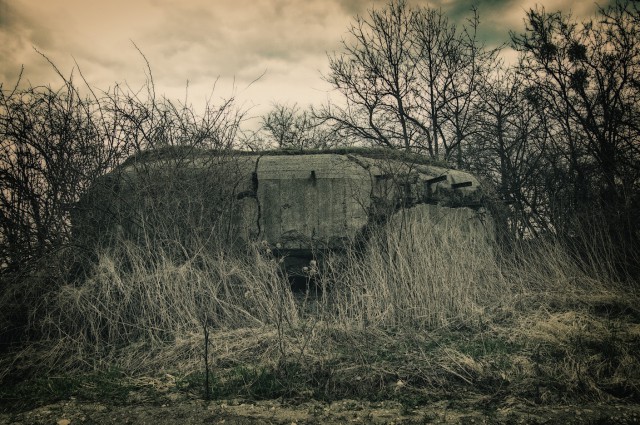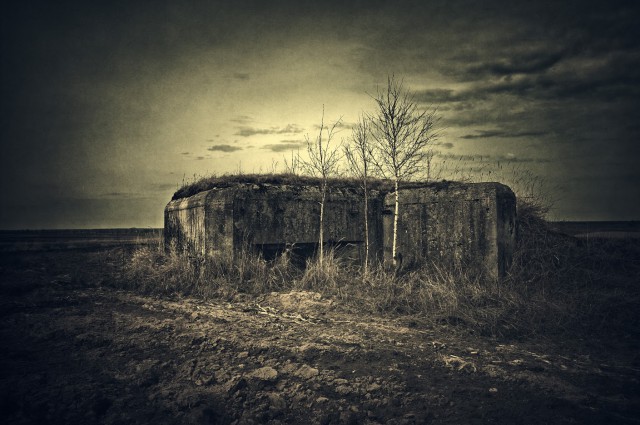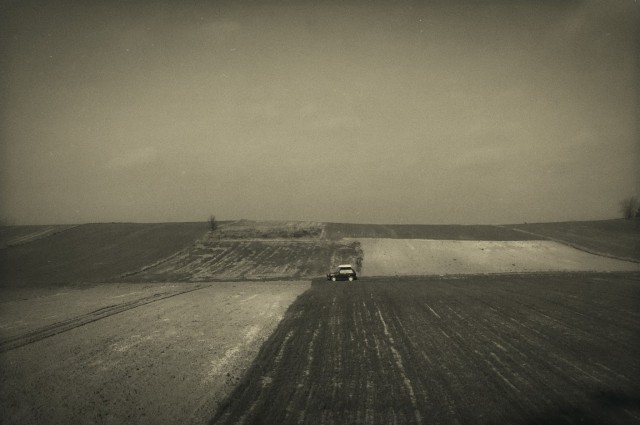
Why the Molotov Line?
Is it because it’s the longest fortification line in Europe? Nah, years ago I haven’t had a clue about it… I used to come around those concrete slabs here and there and, coming from a family with a long military tradition, I was drawn to those sites like a moth is drawn to a candle. And they were Soviet made – this fact peaked my interest, because who cared about Soviets? Westwall, Maginot Line – oh yes, no need for a degree in history for those names to ring a bell. But the Molotov Line? It was not even called by that name. In fact it has never had any name at all.
And so I simply had to know.
Years ago, cruising on the web, I came around a small group of enthusiasts apparently researching the subject. Or, at least, putting the pins on the maps… I contacted them but they were strangely reluctant to cooperate. In fact I had little, or nothing, to offer. I was spending a lot of time cruising on my motorbike and was looking for interesting locations to shoot. I had no knowledge and they were reluctant to share theirs. I disliked them immediately!
Years had passed and the group evolved into a serious historical society doing a very serious, professional research work solely devoted to the Molotov Line. And, to cut the long story short, I took a horrible revenge on them. After all those years I became a president of the society…

So what is the Research Group “Kriepost” doing then? How about mapping all the pillboxes of the Molotov Line? There are about 5.000 of them – from the ones which remained at the initial stage of construction to the fully completed ones. Precise and meticulous measurements, CAD drawings, GPS locations, azimuths of fire for each and every loophole of each and every pillbox, photographic documentation, detailed maps and reconstruction of locations of antitank ditches screening the strongpoints, narrow track railways (all gone by now), details of units, names, numbers…
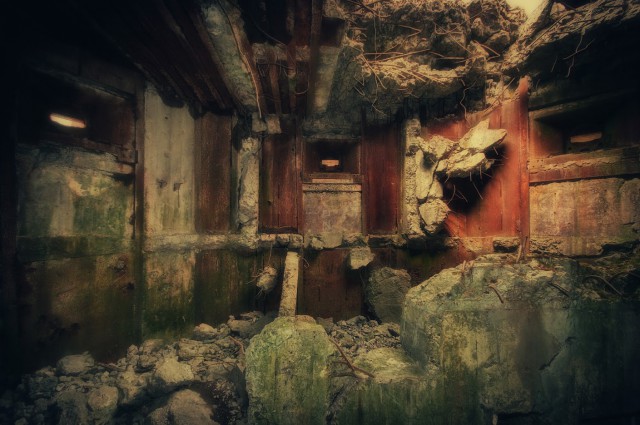
There is a lot to do on a fortification line touching the Baltic shore in Lithuania and going down the map across Poland, Belarus, Ukraine and into Romania. This is a monumental work: lots of traveling (all at your own cost, in case you wonder!), endless days of searching for elusive locations in the vast forests of Poland and Lithuania, tons of paperwork and permissions to work in the “off-limits” border zone in Belarus, hours spent on deciphering types and dimensions of pillboxes blown into oblivion by massive internal explosions, shuffling through waypoints, track logs and tons of numbers. Adventure of a lifetime:) A huge publication one day? Yes, maybe. But until then there are still hundreds of places to locate and visit.

And yet, except for the purely “technical” work there is something else which makes the “Soviet military architecture” a very special one. There are untold stories of thousands of unnamed people entangled in the merciless machinery of forced labor – a trademark of the Soviet empire.
There are norms stipulating how many cubic meters of sand a kid with a shovel should dig and how far it should be moved. Under the thick layer of propaganda, which had accumulated over the years, there are rare memoirs of those who witnessed incredible inefficiency of the “defense building effort”, who saw mass desertion and defeat and dared to speak about it. And then there are ultimate gems – the stories of the old people who still remember how it really worked and what was the price.
There is indeed something magic about the glaring contrast between the vast resources mercilessly poured into this fortification effort and it’s final fate – the one of ultimate uselessness and defeat.

Interestingly, those who designed and built this monumental defense line never considered themselves to be participants of the WW2. Aggression against Finland, Baltic republics, Romania and finally joint Hitler-Stalin attack on Poland in 1939 is still considered to be a period of “peaceful prosperity” – even in today’s Russia. They did not consider themselves to be participants even when foundations of thousands of pillboxes were laid down as a screen for deployment of vast armies which were supposed to march on Europe. It all changed on the early morning of 21 June 1941 when the Wehrmacht steamroller crashed through the German-Soviet border – all across what the Soviets called “former Poland”.

And so ‘The Molotov Line Journals” are a small window into the past, into the vast treasure trove of knowledge which may help to understand the present day.
Because history often likes to repeat itself. And because there are things which never change.
War never changes.
Please read the Introduction – Part 1 for more information regarding the Molotov line.
This ruined three-loophole machinegun pillbox still retaines its outer shape. But there’s no layer of reinforced concrete thick enough to withstand a huge internal explosion. Dozens of artillery or mortal shells deliberately placed inside, sometimes coupled with dedicated explosive material, result in a detonation which wipes the interior clean.
Fighting chambers and interior walls evaporate, floor collapses down into the storey below and the mighty structure breaks open.Hours and days of hard labor, sweat and cursing, hunger and fear – everything useless, everything forgotten, the whole world turned into rubble now cracklling under my feet.This is how empires collapse.
A simplified version of an antitank pillbox. No hydraulics, no armor housings, just a concrete slab designed to protect a 45 mm antitank field piece which was simply rolled inside.These kind of bunkers were usually pushed to the foreground, usually several kilometers ahead of the main defense line.
In this particular area Soviet border in 1941 formed a sharp bulge dangerously protruding into German territory, just begging to be cut off. Main strongpoints were therefore built farther to the rear and the borderline was screened with a number of simplified constructions.Still, they were unmanned and were generally left undefended and therefore were quickly bypassed by the advancing Germans.
Still partially covered with its protective embankment, a single-chamber pillbox idles on an endless field – along with more than a dozen similar ones.
They were supposed to screen the main defence line located several kilometers to the south-east, on the approaches to the Carpathian Mountains.Such simplified pillboxes, with no elaborate plumbing or air-exchange systems were supposed to fulfill an almost suicidal task – to give an early warning and force a deployment of the enemy, thus buying precious time for the main strongpoints to prepare for the onslaught.
None of them has ever seen any combat, just as most of the key strongpoints they were supposed to screen.In 1941, when hell broke loose, the German advance was too swift and the defence, except for isolated pockets of resistance, never truly materialized.

Another shot of simplified version of a heavy machine gun pillbox. The guys were supposed to put their Maxim on a table-like base and just fire away.Again, this one was abandoned early on and never saw combat. Whatever crew was supposed to man it (if there had ever been any), it never reached the post.
A simplified version of the smallest Molotov Line pillbox for one heavy machine gun. Even these simple form of fortification could prove to be a pain for the attackers. Well hidden under the protective embankment they are quite difficult to spot even today.
Here just the entrance to the pillbox is barely visible, the single loophole is on the opposite side.Numerous pillboxes of this type screened the main defensive line in the south-eastern part of the Molotov Line but they were all abandoned by the Soviets and none took part in combat during the opening hours of the German advance into Soviet Union in 1941.
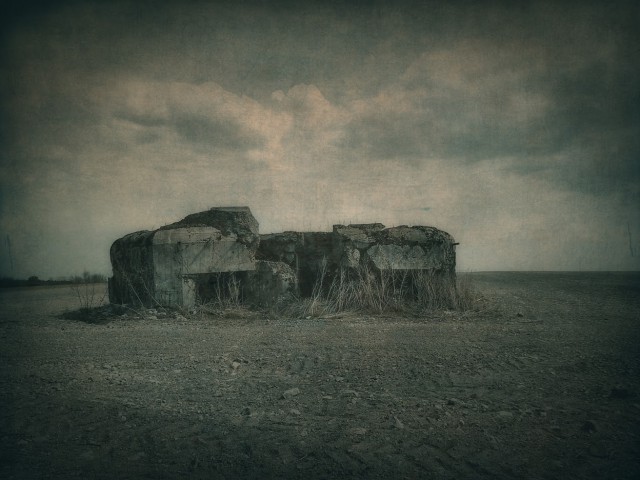
This anti-tank semi-caponier was equipped with one 45 mm gun and three heavy machine guns. Part of the Molotov Line, located in south-east Poland and western Ukraine, was almost catching up with the construction schedule in 1940-41, with many of the pillboxes almost fully equipped and armed.
Consequently some of the strongpoints showed stubborn resistance during the opening hours of the German-Soviet war.The structure is heavily damaged with the roof cracked open and some serious internal damage which is a direct result of deliberate action of the German pioneers who had blown off the armored housings of the guns.
Small concrete slabs, silent witnesses of history, are often hidden in vast forests, entagled in brushes, dark and foreboding as if the nature itself was ashamed of them and tried to do its best to swallow them forever.Sometimes it takes hours to find them, hauling the gear knees deep in water, just to have a glimpse of them.
But sometimes they idle on seemingly endless fields with no country roads to approach them and where my car rises apocalyptic clouds of dust and sand scorched by sun.I love going there alone – they are ultimate kingdoms of solitude where time stands still.
This single-chamber pillbox for two Maxim heavy machineguns is part of Podbiele strongpoint which compactly packs 20 bunkers on a small area. Still 3 more were supposed to be built there but the construction had never progressed beyond the initial earthmoving stage.Further 27 pillboxes are located just nearby, sitting tightly on both sides of the vital Warsaw-Białystok-Grodno road, and they form another strongpoint (Prosienica).
The old German-Soviet border was just 5 km away and these strongpoints, along with anti-tank ditches, were supposed to protect that vital communication line. In June 1941 there were a lot of Soviet troops in the area but most of them were infantry batallions detached from their regiments and used as an emergency workforce for construction of field defences. They had no geat willingness – and no real possibility – to stem the German advance.
It is difficult, and sensless, to fight when armed only with a shovel. There are very few original German photographs of these pillboxes. Two or three were indeed snapped by some adventurous souls but they are the ones located just near the Warsaw-Grodno road. But at this initial stage the advancing Germans had probably never even seen most of those pillboxes scattered on the fields and hidden in the clusters of trees.Later, when the frontline moved hundreds of kilometers further to the east, some pillboxes were used as testing sites for various explosives and many were seriously damaged when armored housings were blown off in order to recover precious metal.
A story of “The Norm”.A pile of stones and some barbed wire, still remembering the summer of 1941.Construction of hundreds of pillboxes of the Molotov Line required huge amounts of stone. It was crushed and mixed with fresh concrete. The best one was coming from the Caucasus Mountains – a long and expensive journey. So, inevitably, local stones were used on a massive scale. But they did not come by themselves. Soviets, as mad and ruthless as they were, were also very precise and rigorous people.
Not content with herding thousands of civilians into forced labor zones, they also came up with a set of precise rules, or “norms”, regulating who, how much, when and how was supposed to contribute to the overall effort of “defence works”.It was carefully planned and calculated how many stones each local farmer had to bring to the building site. You’ve got a horse? Two? If two, then you need to bring more. It was that simple. No horse? You will dig foundation trenches then or, better even, endless anti-tank ditches.
There were norms stipulating how many cubic meters of earth one needs to remove and what is the distance that removed portion needs to be moved away.I always go around those remote, small villages asking about anti-tank ditches. As huge as they had been, they are hard to find today, most eaten up by forests and cultivated fields. But every piece of information is precious when drawing the maps of those forgotten strongpoints. I’m always very careful not to overuse the technical and military jargon – these are mostly simple people I talk to.
But most often than not I found myself disappointed that they did not understand what I was asking about. It’s a simple thing – an anti-tank ditch – even the name implies it, hey, it;s just a damn, deep ditch, that’s all about it!And then, to my horror, the answers started to pop out like a devil from the box. Of course they knew what an anti-tank ditch was! I was simply asking a wrong question… They had a different word for an anti-tank ditch. The one they remembered from their fathers and grandfathers, the one which which was so feared as it was hated, the one so horrible it stuck in the minds of simple folk for generations.The called it “the norm”.
This unfinished two-loophole heavy machine gun pillbox sits quietly on what looks like an average field. But this is a very, very wet field. All pillboxes in the area of Jurbarkas, Sakiai, Taurage, etc are literally flooded with water. Some, located in the forests, require pontoons to get to them.
They even look wet from the outside. Excess of water is appalling and this is something which forced the builders in 1940/141 to set some of the pillboxes on a wider substructures to prevent them from literally sinking into the ground. Amazingly, just couple of kilometers to the south those who constructed neighboring strongpoints faced a desperate shortage of water and they had to scrap for every bucket of the precious liquid. Humans are never happy.
In 1940/41 Soviet builders did not waste precious military manpower for initial preparation work required during the construction process of their pillboxes of the Molotov Line. Instead, local population was herded into the place and was forced to do all the digging and earthmoving. Their highly sophisticated forced labor system allowed for widespread usage of local manpower consisting of inhabitants of the newly conquered eastern part of Poland.
It was a hard job made worse by strictly imposed norms. No excavators were used and everything was done manually. Still, the construction effort along the “new” border of the Soviet Union was so huge that even these resources were not enough. Prisoners were therefore used on a large scale, too.Once the hard work was done the “unsecure” elements were moved away and the military moved in. Usually, a tall wooden fence was first built around the perimeter to hide the construction site from the eyes of enemies.
This term, of course, included the local population, too.What you see on the photo is an unfinished two-machine gun pillbox. Surely a large number of local population laboured during the excavation here before the concrete work could begin. Time was running short for the Soviets and he construction was abandoned during the early stage, proving to be just another useless curiosity for the Germans who crashed through the border in June 1941.Such unfinished pillboxes are also silent and tragic monuments to the hardships endured by countless people who were forced to slave away under the watchful eye of their Soviet masters.
Piotr Tymiñski
